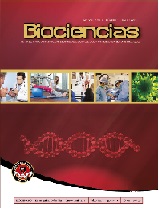Helicobacter Pylori
Avances en inmunogenética y metodologías diagnósticas
DOI:
https://doi.org/10.18041/2390-0512/bioc..1.2766Palabras clave:
Helicobacter pylori, Inmunogenética, Úlcera pépticaResumen
En 1982, Marshall y Warren descubrieron una bacteria que sobrevive en medio ácido y coloniza la mucosa gás- trica, llamada Helicobacter pylori, presente en pacientes con gastritis y úlcera péptica; su prevalencia en adultos de países occidentales está entre 20 y 40% y en países en vías de desarrollo en aproximadamente 80%. El conoci- miento de sus características inmunológicas, metabólicas y patogénicas, ha facilitado avanzar en el diagnóstico y prevención de enfermedades gastroduodenales relacionadas con ella. La infección se ha asociado con expresión de alelos específicos HLA-DR del tracto gastrointestinal humano, sugiriendo un papel en el desarrollo de gastritis crónica. Actualmente existen muchas pruebas para su detección, destacándose el test del aliento, por ser la más sensible y específica. El objetivo de esta revisión es el de evidenciar los conocimientos en la inmunogenética de la bacteria y los avances en las metodologías para su diagnóstico.
Descargas
Referencias
Marshall BJ, Warren JR. Unidentified curved bacilli in the stomach of patient with gastritis and peptic ulceration. Lancet. 1984; 1:1311-5.
Warren JR. Unidentified curved bacilli on gas- tric epithelium in active chronic gastritis. Lan- cet 1983; 1: 1273-5.
Hazell SL. Isolation of Helicobacter heilmannii from human tissue. Eur J Clin Microbiol Infect Dis. 1996; 15:4-9.
González CM. Aspectos epidemiológicos de mayor relieve de la infección por Helicobacter pylori. En: González-Carbajal M. y cols. Helico- bacter pylori ¿El tercer dogma? Madrid, Espa- ña: Autores Productores Asociados, S.L. Capí- tulo. 2003: 83-112.
Rautelin H y Kosunen TU. Helicobacter pylori infection in Finland. Ann Med. 2004; 36(2):82- 8.
Taylor DN, Blaser MJ. The epidemiology of Heli- cobacter pylori infection. Epidemiol Rev. 1991; 13:42-59.
Hill M. Helicobacter pylori: microbiology. Eur Cancer Prev 1996; 26:4-5.
Logan RPH, Walker MM. Epidemiology and diagnosis of Helicobacter pylori infection. Br Med J. 2001; 232:920-2.
Megraud F, Brassens-Rabbe MP, Denis F, Bel- bouri A, Hoa DQ. Seroepidemiology of Cam- pylobacter pylori infection in various popula- tions. J Clin Microbiol. 1989; 27:1870-3.
Holcombe C, Omotara BA, Eldridge J, Jones DM. Helicobacter pylori, the most common bacteria infection in Africa: A random serologi- cal study. Am J Gastroenterol. 1992; 87: 28-30.
Pounder RE, Ng D. The prevalence of Helico- bacter pylori infection in different countries. Aliment Pharmacol Ther. 1995; 9:33-9.
Goodman K, Correa P, Tenganá HJ et al. Heli- cobacter pylori infection in the Colombian An- des. A population-based study of transmission pathways. Am J Epid. 1996; 144: 290-9.
Bravo LE, Cortés A, Carrascal E, Correa P, Or- dóñez N. Seroprevalencia de anticuerpos anti- Helicobacter pylori en donantes de sangre de regiones colombianas con diferencias en la mortalidad por cáncer gástrico. Colomb Med. 2000; 31:122-130.
Moncayo JI, Santacruz JJ, Montes ML, Fran- co B, López M, Meissel E, et al. Utilización de la reacción en cadena de la polimerasa (RCP) para el diagnóstico de la infección por H. pylori en pacientes con enfermedad úlcero-péptica. Rev Med Ris 2002; 8:4-10.
Velanovich V. The spectrum of Helicobacter pylori in upper gastrointestinal disease. Am Surg. 1996; 62:60-3.
Suerbaum S, Michetti P. Helicobacter pylori In- fection. N Engl J Med 2002; 347:1175-86.
McNulty CAM, Wyatt JI. Helicobacter pylori. J Clin Pathol. 1999; 52:338-44.
Sleisenger, Fordtran, Feldman, Scharschmidt, Sleisenger. Enfermedades gastrointestinales y hepáticas. Fisiopatología, diagnóstico y trata- miento. 7ª ed, 2004. Editorial Médica Paname- ricana, Vol 2.
Thomas JE. Epidemiology of infection. Curr Op Gastroenterol. 1994; 10:7-11.
Trowsdale J, Ragoussis J, Campbell R. Map of the human MHC. Immunol Today 1991; 12: 443-6.
Azuma T, Konishi J, Ito Y, Hirai M, Tanaka Y, Ito S, et al. Genetic differences between duodenal ulcer patients who were positive or negative for Helicobacter pylori. J Clin Gastroenterol. 1995; 21(Suppl. 1):151-4.
Azuma T, Ito, Sato F, Yamasaki Y, Miyaji H, Ito Y, Suto H, Kuriyama M. The role of the DQA1 ge- nes in resistance to atrophic, gastritis and gras- tric adenocarcinoma induced by Helicobacter pylori infection. Cancer. 1998; 15:1013-8.
Sakai T, Aoyama N, Satonaka K, Shigeta S, Yo- sida H, Shinoda Y, Shirasaka D, Miyamoto M, Nose Y, Kasuga M. HLA DBQ locus and the development of atrophic gastric with Helico- bacter pylori infection. J. Gastroenterol, 1999; 34(Suppl 11):24-7.
Perri F, Piepoli A, Quitadamo M, Quarticelli M, Merla A, Bisceglia M. HLA-DQA1 and -DQB1 genes and Helicobacter pylori infection in Ita- lian patients with gastric adenocarcinoma Tis- sue Antigens. 2002; 59(1):55-7.
Gatta L, Ricci C, Tampieri A, Vaira D. Non-inva- sive techniques for the diagnosis of Helicobac- ter pylori infection. Clin Microbiol Infect. 2003; 9:489-96.
Vaira D, Gatta L, Ricci C, Miglioli M. Review ar- ticle: diagnosis of Helicobacter pylori infection. Aliment Pharmacol Ther. 2002; 16 (1):16-23.
Megraud F. Comparison of non-invasive tests to detect Helicobacter pylori infection in chil- dren and adolescents: results of a multicenter European study. J Pediatr. 2005; 146:198-203.
Trakarnvanich V. Methylene blue staining of gastric tissue for the identification of Helico- bacter pylori. South Asian J Trop Med Public Health. 2007; 38:78-81.
Brooks HJ, Ahmed D, McConnell MA, Barbezat GO. Diagnosis of Helicobacter pylori infection by polymerase chain reaction: is it worth it? Diagn Microbiol Infect Dis. 2004; 50:1-5.
Martínez Gómez MJ, Urruzuno P, Cilleruelo ML et al. Test del aliento con Urea-C13 en el diag- nóstico de la infección por Helicobacter pylori en niños. Ann Esp Pediatr 1995; 69: 56-7.
Van KN, Van HE, de Boer WA. Validation of a new, commercially available dry rapid urease test for the diagnosis of Helicobacter pylori in- fection in gastric biopsies. Neth J Med. 2006; 64:329-33.
Gatta L, Ricci C, Tampieri A, Vaira D. Non-inva- sive techniques for the diagnosis of Helicobac- ter pylori infection. Clin Microbiol Infect. 2003; 9:489-96.
Megraud F. Comparison of non-invasive tests to detect Helicobacter pylori infection in chil- dren and adolescents: results of a multicenter European study. J Pediatr. 2005; 146:198-203.
Kato S, Tachikawa T, Ozawa K, Konno M, Oku- da M, Fujisawa T, et al. Urine-based enzyme- linked inmunosorbent assay for the detection of Helicobacter infection in children. Pedia- trics. 2001; 107(6):E87.



